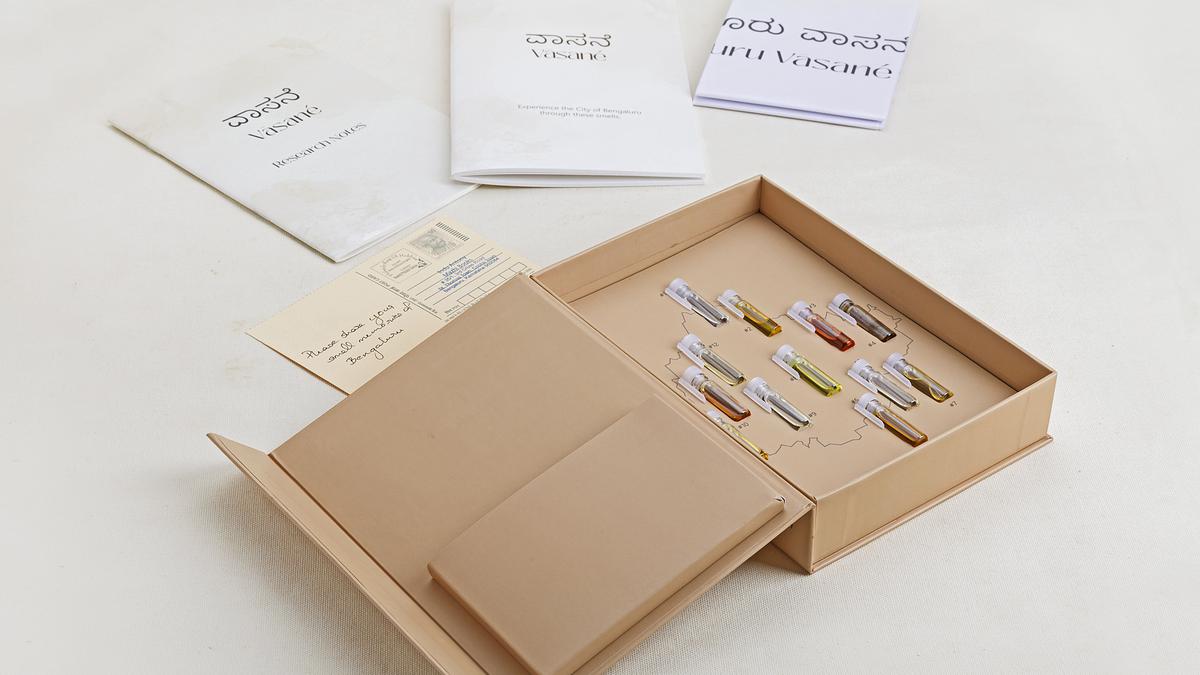
The many smells of Bengaluru captured in a book Premium
The Hindu
Vasané (smell in Kannada), an olfactory art project by the Bengaluru-based artist, which attempts to chronicle the different smells of Bengaluru
Indu Antony still remembers her experience of visiting Church Street, when she moved to Bengaluru 21 years ago. “We used to dress up and walk up and down that road to get noticed,” she says, pointing out that the area is always filled with a young crowd, the romance and tension in the air as palpable as the lingering odour of charred cigarettes.
The smell of cigarettes becomes a metaphor for heartbreak inVasané (smell in Kannada), an olfactory art project by the Bengaluru-based artist, which attempts to chronicle the different smells of the city. Packaged in a limited-edition book format, the project has several sections, including a postcard, small vials of scent, a scent map of the city and some research notes about the project.
One of the things documented in these notes is the history of olfactory art, suggesting that it could have originated back in 1938, when the French artist Marcel Duchamp, a pioneer of the avant-garde Dada art movement that revolutionised the way people perceived art, filled a show with the aroma of roasting coffee. “The idea of commodifying olfactory art is challenged by the ephemerality and immateriality of odours,” she writes in this booklet, pointing out that though olfactory art has a long history, it is often limited by the demands of the art market.
Vasané, interestingly, manages to get past this challenge in its current format. The book, which is priced at ₹3500, offers a way to merge the transient with the tangible, allowing its purchaser to bring home a whiff — no, many whiffs — of Bengaluru. “I wanted it to be an experiential thing,” says Antony, who thinks of it as an art-as-an-experience book through which one encounters the city.
Unlike a city like Chennai, where the briny scent of the sea overpowers everything, Bengaluru has pockets of different smells, believes Antony who began work on the project during the pandemic, “when everyone was wearing masks and were not able to smell the city.” She started by talking to people, asking them about their smell memory of the city. “A lot of people talked about similar smells,” recalls the artist, who went on to pick the 12 most common ones, including the aforesaid mentioned cigarettes, filter coffee, Mysore Sandal soap and Bellandur lake.
Talking about the science behind the project, she points out that the olfactory nerve, instrumental in shaping our sense of smell, is very close to the amygdala, the part of the brain that processes the emotions associated with a particular memory. “In Bangalore, as you know, people constantly talk about nostalgia,” says Antony, pointing out that the city has seen a large amount of development in a really short span of time. “People want to hold on to a certain kind of memory and having a smell memory brings in a lot of emotion.”
On the long white-covered benches that fill the viewing room at the Indian Institute for Human Settlements, where Vasané was recently exhibited, are placed a number of glass cloches, an envelope beside each one. Visitors weave between the benches, pick up and sniff into the cloche, and try to guess the scent. “I think this is cake,” says one, before opening up the envelope to confirm his guess. He’s not far off the mark: the scent, as the envelope reveals, is an attempt to bottle the memory of passing by the iconic Iyengar bakery, redolent with the aroma of freshly-baked bread and delicious confections.

Capt. Brijesh Chowta, Dakshina Kannada MP, on Saturday urged Union Finance Minister Nirmala Sitharaman to facilitate speeding up of ongoing critical infrastructure works in the region, including Mangaluru-Bengaluru NH 75 widening, establishment of Indian Coast Guard Academy, and merger of Konkan Railway Corporation with the Indian Railways.










